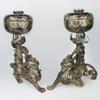Beauty Set In Stone: The Art of Pietre Dure
- April 12, 2013 10:27
The art form developed in ancient Rome in the 4th century where the technique was known as opus sectile (“carved and cut work”). Much like mosaic, this new process utilized larger sections of materials such as marble and glass inlaid into floors and walls to compose an image or decorative pattern. After the fall of the Roman Empire, the technique was brought to Byzantium, where it was used to grace the interiors of churches. It wasn’t until the Italian Renaissance that we find the first mentions of pietre dure.
In 1588, Grand Duke Ferdinando I de’ Medici established in Florence the Grand Ducal Workshop Galleria di’Lavori, known today as the Opificio delle Pietre Dure (“Workshop of Semi-Precious Stones”). The Medici family is historically renowned for their support and influence upon the arts, and this workshop specialized specifically in the perfection of pietre dure, elevating it into the most important of the Florentine art forms. Pietre dure soon became a favorite of monarchs around the world, and everyone from France’s Louis XIV to the Hapsburgs in Prague sought out these splendid creations to craft some of the most exquisite objets d’art the world has ever known.
Precision is key when creating pietre dure. The artisan first selects only the finest specimens of marble, semi-precious and, in some cases, precious stones, to compose his work. Since these elements literally come in every color of the rainbow, the creative possibilities are truly endless. Once the artist has created his design on paper, the individual elements of the image must be delicately cut from the materials to exact proportions, as each must fit together perfectly, much like the pieces of a puzzle, to compose the final work of art. Upon examination of this magnificent Florentine Pietre Dure plaque of a gentleman serenading a young woman, the level of care and attention afforded to its creation is awe-inspiring. Vivid blues, reds and greens from various marbles and lapis lazuli are used throughout to create a dynamic scene. Everything from hair and eyes, to clothing and mandolin strings are cut to exact size from individual stones and then painstakingly inlaid one into the other. It is no wonder that it could take months, even years, to complete a single work of pietre dure depending on its size and complexity.
From large genre scenes to wonderful decorative objects such as these Pietre Dure Plinths, works displaying this amazing artistic technique continue to attract the attention of collectors throughout the world.
To view M.S. Rau Antiques’ selection of pietre dure, click here.

















100x100_c.jpg)


